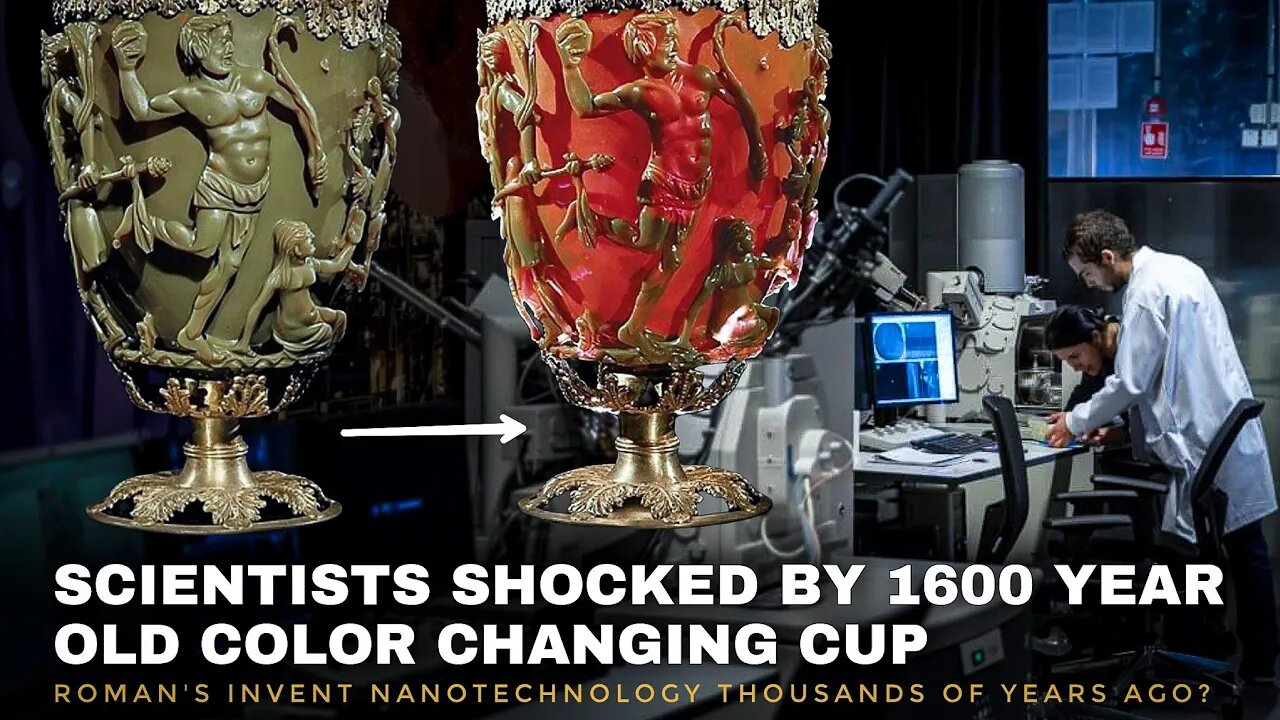Premium Only Content

"World's Oldest Evidence of Advance Nanotechnology Found | Scientists Uncover
World's Oldest Evidence of Advance Nanotechnology Found | Scientists Uncover
This cup has a special property that causes its color to vary depending on the direction or strength of the light. How could this cup do such a remarkable task? And was nanotechnology employed during the production process? Was this technology developed by the ancient Romans at that time, or was it just a coincidence?
Let's find out.
A beautiful example of Roman glassmaking is the jade-green chalice with the carefully etched picture of King Lycurgus twisted in grapevines. However, the fundamental innovation of these Roman artists—their use of nanotechnology—can only be appreciated upon closer inspection.
Most likely a ceremonial cup, the Lycurgus Cup from the fourth century is now housed at the British Museum. It shows King Lycurgus of Thrace impaled on vines, allegedly for insulting the wine deity Dionysus in Greek mythology.
It's interesting that no one knows why the Lycurgus Cup's color changes under illumination. Was there a ritual involved? Was it a ruler's tool for detecting poison? Was it only to exhibit light and color so exquisitely?
One of the earliest products to use nanotechnology was the "Lycurgus Cup." Even while it is unlikely that the creators were aware of the explanation for the exceptional optical properties of the cup, modern science has shown just how sophisticated the manufacturing procedures used to create the cup were.
The Story Behind the Cup
An enigmatic artifact from the end of the Roman era is called the Lycurgus Cup. It's a "cage cup," which means that a lovely "cage" pattern surrounds the main cup. King Lycurgus of Thrace's rage and demise are shown in this cage's design.
King Lycurgus is depicted in at least one Greek and Roman tale as attempting to murder Ambrosia, a devotee of the deity Dionysus. This interpretation of the story claims that Ambrosia was turned into wine by the gods, who then gathered around the monarch and slaughtered him. Two of Dionysus's disciples make fun of the hapless monarch on the cup relief.
Nanotechnology Properties
The "Lycurgus Cup" is not only a gorgeous work of art but also a very expensive one. The cup is priceless since it was made using precious metals like silver and gold.
It's interesting that no one knows why the Lycurgus Cup was designed to change color when lighted. Was there a ritual involved? Was it a ruler's tool for detecting poison? Was it only to exhibit light and color so exquisitely?
Engineer Gang Logan Liu from the University of Illinois at Urbana-Champaign believes there is a benefit to investigating this object and its technology. He has been concentrating on how to diagnose and treat diseases using nanotechnology. Liu claims that the Romans were skilled in creating and utilizing nanoparticles for exquisite art. We were interested in exploring any potential scientific uses for this. Liu postulated that when a treated vessel was filled with various liquids, the vibrating electrons would change the color of the glass accordingly. The Lycurgus Cup couldn't be used in the experiment for fear of damage. Instead, the researchers
"...created an array of billions of incredibly small Lycurgus Cups by imprinting countless tiny wells onto a plastic plate the size of a postage stamp and dousing them with gold or silver nanoparticles. The wells showed a variety of easily distinguishable colors when water, oil, sugar solutions, and salt solutions were put into them, such as light green for water and red for oil. The prototype's sensitivity to changed salt levels in solution was 100 times greater than that of comparable commercial sensors now on the market.
Therefore, a technology created 1,600 years ago has the potential to be used today. It raises the question of what nanotechnology actually is. Is this science insanity? A revolution in atomic engineering? the two?
In essence, nanotechnology involves controlling systems and processes at the atomic scale—a world so tiny that it is beyond the comprehension of non-scientists. The word "nanotechnology" is a Greek word that means "dwarf." What kind of scale are we referring to? "A nanometre is a very small unit of measurement that is one billionth (10-9) of a meter in length, or around 100,000th of the breadth of a human hair.
The last 20 years have seen a development in nanotechnology. A substantial effort is currently being made to develop applications for the research's continuous usage. Nanobots have the potential to locate and eliminate cancer cells. Modern surgical instruments, diagnostic methods, and medication delivery systems have the potential to change medicine. Nanotechnology has promise for antiterrorism programs since it can swiftly ascertain the make-up of unidentified liquids, chemicals, and substances to stop assaults.
#ancientsecrets #history #unsolvedmysteries
-
 1:00
1:00
MindSet Code Ph
2 years ago $0.28 earned2023 Zombie Virus is Out be Aware
9491 -
 1:07:14
1:07:14
DeVory Darkins
1 hour agoBREAKING: Washington Post suffers Major SETBACK after Hegseth story gets debunked
34.2K32 -
 LIVE
LIVE
StoneMountain64
1 hour agoArc Raiders EXPEDITION Money Making is Insane
308 watching -
 LIVE
LIVE
Side Scrollers Podcast
3 hours agoTwitch has a SERIOUS Problem + Leaflit’s VIRAL Interview + More | Side Scrollers
694 watching -
 LIVE
LIVE
Barry Cunningham
17 hours agoBREAKING NEWS: President Trump Hosts Cabinet Meeting & Makes MAJOR Announcement!
1,871 watching -
![Wall Street CRASHED Bitcoin DOWN To $80,000!! [Heres Proof] | EP 1389](https://1a-1791.com/video/fww1/dc/s8/1/G/E/S/E/GESEz.0kob-small-Wall-Street-CRASHED-Bitcoin.jpg) LIVE
LIVE
Simply Bitcoin
2 hours ago $0.28 earnedWall Street CRASHED Bitcoin DOWN To $80,000!! [Heres Proof] | EP 1389
197 watching -
 1:02:19
1:02:19
Timcast
2 hours agoMedia MELTS DOWN Over New Media Pentagon Takeover
92.5K36 -
 2:04:40
2:04:40
Steven Crowder
4 hours agoWar Criminal Pete Hegseth: Debunking the Media's Newest BS Smear Campaign
352K242 -
 59:57
59:57
The Rubin Report
3 hours agoPress Gasps When Told Trump’s Brutal Plan for Venezuela
29.9K78 -
 LIVE
LIVE
Benny Johnson
4 hours ago🚨Trump Cabinet Meeting LIVE Now in White House As Somali Fraud EXPOSED, Third World Deportations
5,241 watching